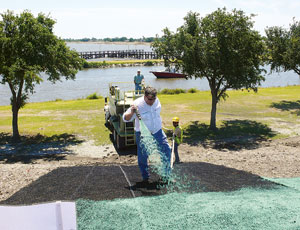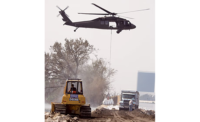In New Orleans, where the U.S. Army Corps of Engineers is spending billions of dollars constructing, elevating and bolstering flood defenses, establishing hardy, fast-growing ground cover to protect levees from erosion and overwash damage is a critical part of the process.
“The name of the game is getting grass established quickly,” says Jeff Beasley, turf-grass physiologist with the Louisiana State University Agricultural Center in Baton Rouge. On May 20, the center partnered with the Corps and Jesco Environmental & Geotechnical Services Inc., Jennings, La., to conduct the first, “possibly annual” course in levee re-vegetation and erosion-control techniques.

“We want contractors to know what we are looking for and inspectors to see what proper application looks like,” says Steve Finnegan, levee-vegetation project manager for the New Orleans District. Greening success has become more of a priority for contractors since September, when the Corps revised specifications to require 75% grass coverage per project “reach” of earthen levees before final payment. Jobs are completed in reaches of 1,000 ft in hurricane season and 5,000 ft in non-hurricane season. “Our old specs were not end-product-related,” Finnegan says. “It was more that the contractors applied material, finished and walked away.” If the grass did not take, the Corps paid for reseeding. “We have shifted the investment from the Corps to the contractor,” Finnegan says.
About 50 contractors and Corps and levee district inspectors attended the course, held on a mock levee built by the East Jefferson Levee District on the Lake Pontchartrain shore. LSU AgCenter representatives and two local hydroseeding companies demonstrated several vegetation and erosion-control products provided by Profile Products LLC, Signal Mountain, Tenn.
Science has advanced tremendously since hydroseeding was invented in 1953, says Marc Theisen, Profile’s vice president of erosion-control solutions. He says products can be matched to growth-rate requirements, soil and slope conditions and environmental and overtopping challenges. But contractors need to know how to deliver quickly and cost-effectively. “Once we get in the field, we are at the mercy of the contractors because they are the ones installing it,” Theisen says. He says Profile has guidelines, but nothing beats a demonstration.
Profile and its local distributor, Louisiana Utilities Supply Co., Baton Rouge, prepared two weeks earlier by pre-installing several wood-and-paper blend products, as well as Profile’s Flexterra FGM, a combination of wood fibers, co-polymer gel, tackifier and interlocking fibers. By May 20, after days of hard rain, performance differences were evident. Profile also demonstrated turf-reinforcement mats, commonly used in high-erosion areas or at transitions. Finnegan described various seeding schemes, such as applying seed directly to TRMs, atop a thin layer of soil or beneath the materials.
Newly constructed levees pose growing challenges due to the soil types typically used, salinity and slope. In 2007, the Corps contracted Jesco, which engaged LSU AgCenter, to help update levee planting specifications. Tom Cousté, senior engineer for Jesco, said the old specs had been written for fields, not levees, “because they had never before built so many levees so fast.”
The team suggested changes and then began testing. The findings prompted the Corps to revise specifications for excavated and borrow material. “We want to make sure the upper 1 ft [on both the slope and atop the levees] is less than 700 parts per million salinity so seed can germinate,” Finnegan says. “If you don’t have the right kind of dirt on the ground, you won’t germinate that seed.”
The new specs require more inspection, so the initial cost is higher. But Finnegan is sure they will save money on reseeding and erosion control. Because jobs stay open as long as a few months to get 75% coverage, contracting officials and contractors will see contracts lingering and pay taking longer. But according to Cousté, in the long run, “this is going to save the Corps a lot of money.”


Post a comment to this article
Report Abusive Comment